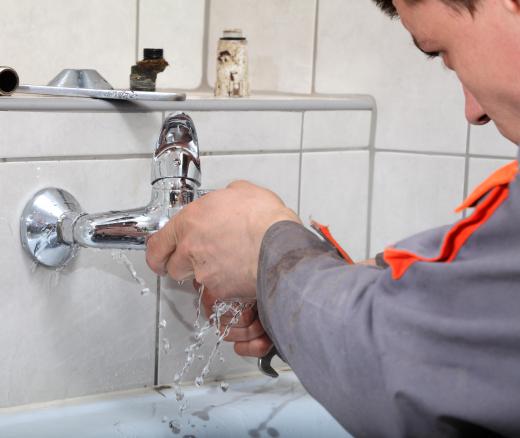A bibcock is a faucet installed at a downward-pointing angle. Also known as a sillcock, this design is especially common for outdoor faucets and some kinds of sink taps. Most hardware and plumbing suppliers carry bibcocks, along with replacement parts, and people can also fabricate their own or order them for custom applications. People sometimes refer to outdoor faucets of this design as hose bibbs, a reference to the fact that they are most commonly used to connect for hoses for watering, washing the car, and similar tasks.
This design often features a threaded tap, allowing people to screw various attachments on. These can include attachments such as screens to distribute the flow of the water evenly, as seen on many kitchen sinks, along with hoses and faucet extenders. A seal is usually needed between the attachment and the faucet to prevent water from leaking out around the threading. The bibcock can be controlled with a variety of valves and taps, typically situated close to the faucet so people can easily turn it on and off.

Depending on the materials used, the durability of a bibcock can vary. Those designed for the outdoors are usually heavy and may have design features intended to prevent freezing. This can be important in cold climates, where pipes can explode in a cold snap and leak water, leading to further damage, as well as waste. Often, pipes are insulated with jackets, but the bibcock must be left exposed, and a poor design can be vulnerable to freezing. Valves designed to check the backward flow of water may also be required to prevent contamination of a water supply.
A common problem with bibocks involves loosening over time of the valve used to control the tap, leading to leaks. Sometimes, a gasket can be replaced, but in other instances, it may be necessary to replace the valve. The water supply should be turned off before doing this kind of work and it may be necessary to call a plumber if the plumbing is complex or if replacing the tap does not seem to address the issue.
In some cases, the building code may require people to install a bibcock for safety or other reasons. Contractors will know more about the plumbing code requirements in a given region and can provide information on adhering to those requirements during construction and remodeling. Plumbers usually install compliant fixtures and supplies when they do installation and repair work, and may sometimes recommend changes to a plumbing system to make it code compliant.
Ever since she began contributing to the site several years ago, Mary has embraced the exciting challenge of being a About Mechanics researcher and writer. Mary has a liberal arts degree from Goddard College and spends her free time reading, cooking, and exploring the great outdoors.

